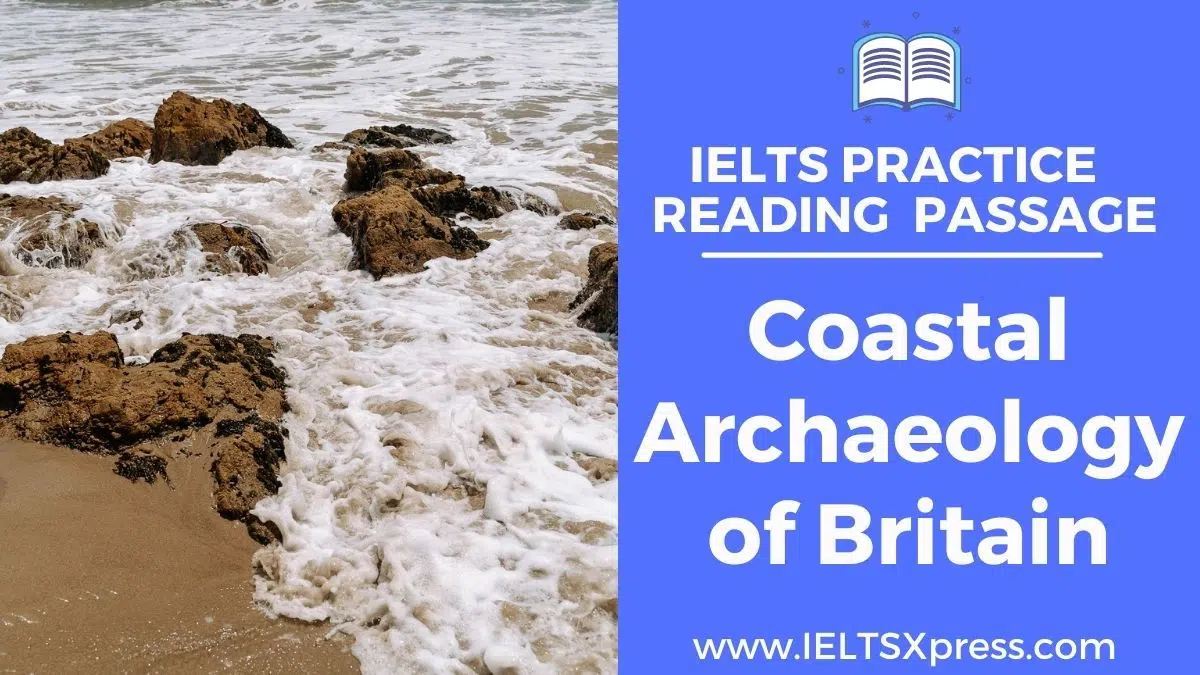Coastal Archaeology of Britain IELTS Reading Passage with Answers
Reading Passage 1
You should spend about 20 minutes on Questions 1-13 which are based on Reading Passage 1 below.
Coastal Archaeology of Britain
A
The recognition of the wealth and diversity of England’s coastal archaeology has been one of the most important developments of recent years. Some elements of this enormous resource have long been known. The so-called ‘submerged forests’ off the coasts of England, sometimes with clear evidence of human activity, had attracted the interest of antiquarians since at least the eighteenth century but serious and systematic attention has been given to the archaeological potential of the coast only since the early 1980s.
B
It is possible to trace a variety of causes for this concentration of effort and interest. In the 1980s and 1990s scientific research into climate change and its environmental impact spilt over into a much broader public debate as awareness of these issues grew; the prospect of rising sea levels over the next century, and their impact on current coastal environments, has been a particular focus for concern. At the same time, archaeologists were beginning to recognize that the destruction caused by natural processes of coastal erosion and by human activity was having an increasing impact on the archaeological resource of the coast.
C
The dominant process affecting the physical form of England in the post-glacial period has been the rise in the altitude of sea level relative to the land, as the glaciers melted and the landmass readjusted. The encroachment of the sea, the loss of huge areas of land now under the North Sea and the English Channel, and especially the loss of the land bridge between England and France, which finally made Britain an island, must have been immensely significant factors in the lives of our prehistoric ancestors. Yet the way in which prehistoric communities adjusted to these environmental changes has seldom been a major theme in discussions of the period. One factor contributing to this has been that, although the rise in relative sea level is comparatively well documented, we know little about the constant reconfiguration of the coastline. This was affected by many processes, mostly quite, which have not yet been adequately researched. The detailed reconstruction of coastline histories and the changing environments available for human use will be an important theme for future research.
D
So great has been the rise in sea level and the consequent regression of the coast that much of the archaeological evidence now exposed in the coastal zone, whether being eroded or exposed as a buried land surface, is derived from what was originally terrestrial occupation. Its current location in the coastal zone is the product of later unrelated processes, and it can tell us little about past adaptations to the sea. Estimates of its significance will need to be made in the context of other related evidence from dry land sites. Nevertheless, its physical environment means that preservation is often excellent, for example in the case of the Neolithic structure excavated at the Stumble in Essex.
E
In some cases, these buried land surfaces do contain evidence for human exploitation of what was a coastal environment, and elsewhere along the modern coast, there is similar evidence. Where the evidence does relate to past human exploitation of the resources and the opportunities offered by the sea and the coast, it is both diverse and as yet little understood. We are not yet in a position to make even preliminary estimates of answers to such fundamental questions as the extent to which the sea and the coast affected human life in the past, what percentage of the population at any time lived within reach of the sea, or whether human settlements in coastal environments showed a distinct character from that inland.
F
The most striking evidence for use of the sea is in the form of boats, yet we still have much to learn about their production and use. Most of the known wrecks around our coast are not unexpectedly of post-medieval date and offer an unparalleled opportunity for research which has as yet been little used. The prehistoric sewn-plank boats such as those from the Humber estuary and Dover all seem to belong to the second millennium BC; after this, there is a gap in the record of a millennium, which cannot yet be explained, before boats reappear, but built using a very different technology. Boatbuilding must have been an extremely important activity around much of our coast, yet we know almost nothing about it. Boats were some of the most complex artefacts produced by pre-modern societies, and further research on their production and use make an important contribution to our understanding of past attitudes to technology and technological change.
G
Boats needed landing places, yet here again, our knowledge is very patchy. In many cases the natural shores and beaches would have sufficed, leaving little or no archaeological trace, but especially in later periods, many ports and harbors, as well as smaller facilities such as quays, wharves, and jetties, were built. Despite a growth of interest in the waterfront archaeology of some of our more important Roman and medieval towns, very little attention has been paid to the multitude of smaller landing places. Redevelopment of harbor sites and other development and natural pressures along the coast are subjecting these important locations to unprecedented threats, yet few surveys of such sites have been undertaken.
H
One of the most important revelations of recent research has been the extent of industrial activity along the coast. Fishing and salt production are among the better-documented activities, but even here our knowledge is patchy. Many forms of fishing will eave little archaeological trace and one of the surprises of the recent survey has been the extent of past investment in facilities for procuring fish and shellfish. Elaborate wooden fish weirs, often of considerable extent and responsive to aerial photography in shallow water, have been identified in areas such as Essex and the Severn estuary. The production of salt, especially in the late Iron Age and early Roman periods, has been recognized for some time, especially in the Thames estuary and around the Solent and Poole Harbor, but the reasons for the decline of that industry and the nature of later coastal salt working are much less well understood. Other industries were also located along the coast, either because the raw materials outcropped there or for ease of working and transport: mineral resources such as sand, gravel, stone, coal, ironstone, and alum were all exploited. These industries are poorly documented, but their remains are sometimes extensive and striking.
I
Some appreciation of the variety and importance of the archaeological remains preserved in the coastal zone, albeit only in preliminary form, can thus be gained from recent work, but the complexity of the problem of managing that resource is also being realised. The problem arises not only from the scale and variety of the archaeological remains, but also from two other sources: the very varied natural and human threats to the resource, and the complex web of organisations with authority over, or interests in, the coastal zone. Human threats include the redevelopment of historic towns and old dockland areas, and the increased importance of the coast for the leisure and tourism industries, resulting in pressure for the increased provision of facilities such as marinas. The larger size of ferries has also caused an increase in the damage caused by their wash to fragile deposits in the intertidal zone. The most significant natural threat is the predicted rise in sea level over the next century especially in the south and east of England. Its impact on archaeology is not easy to predict, and though it is likely to be highly localised, it will be at a scale much larger than that of most archaeological sites. Thus protecting one site may simply result in transposing the threat to a point further along the coast. The management of the archaeological remains will have to be considered in a much longer time scale and a much wider geographical scale than is common in the case of dry land sites, and this will pose a serious challenge for archaeologists.
Questions 1-3
Choose the correct letter, A, B, C or D.
Write your answers in boxes 1-3 on your answer sheet.
1 What has caused public interest in coastal archaeology in recent years?
A Golds and jewelleries in the ships that have submerged
B The rising awareness of climate change
C Forests under the sea
D Technological advance in the field of sea research
2 What does the passage say about the evidence of boats?
A We have a good knowledge of how boats were made and what boats were for prehistorically
B Most of the boats discovered was found in harbors
C The use of boats had not been recorded for a thousand years
D The way to build boats has remained unchanged throughout human history
3 What can be discovered from the air?
A Salt mines
B Shellfish
C Ironstones
D Fisheries
Questions 4-10
Do the following statements agree with the information given in Reading Passage 1?
In boxes 4-10 on your answer sheet, write
TRUE if the statement is true
FALSE if the statement is false
NOT GIVEN if the information is not given in the passage
4 England lost much of its land after the ice-age due to the rising sea level.
5 The coastline of England has changed periodically.
6 Coastal archaeological evidence may be well-protected by seawater.
7 The design of boats used by pre-modern people was very simple.
8 Similar boats were also discovered in many other European countries.
9 There are a few documents relating to mineral exploitation.
10 Large passenger boats are causing increasing damage to the seashore.
Questions 11-13
Choose THREE letters A-G
rite your answer in boxes 11-13 on your answer sheet
Which THREE of the following statements are mentioned in the passage?
A Our prehistoric ancestors adjusted to the environmental change caused by the rising sea level by moving to higher lands.
B It is difficult to understand how many people lived close to the sea.
C Human settlements in the coastal environment were different from that inland
D Our knowledge of boat evidence is limited.
E The prehistoric boats were built mainly for collecting sand from the river.
F Human development threatens the archaeological remains.
G The reason for the decline of the salt industry was the shortage of laborers.
Coastal Archaeology of Britain IELTS Reading Passage Answers
Practice with Expert IELTS Tutors Online
Apply Code "IELTSXPRESS20" To Get 20% off on IELTS Mock Test
1. B
2. C
3. D
4. TRUE
5. FALSE
6. TRUE
7. FALSE
8. NOT GIVEN
9. TRUE
10. TRUE
11. B
12. D
13. F
Also Check: Bovids IELTS Reading Passage with Answers
Coastal Archaeology of Britain IELTS Reading Answers Explanation
Question 1. What has caused public interest in coastal archaeology in recent years?
Answer: B. The rising awareness of climate change
Supporting sentence: “In the 1980s and 1990s scientific research into climate change and its environmental impact spilled over into a much broader public debate as awareness of these issues grew; the prospect of rising sea levels over the next century, and their impact on current coastal environments, has been a particular focus for concern.”
Keywords: climate change, rising sea level, coastal environments
Keyword Location: paragraph B
Explanation: As scientists started to research climate change and awareness among the people increased, the topic became highly discussed, and the impact of rising sea levels on coastal environments became a concern. The public concern made coastal archaeology a topic of interest.
Question 2. What does the passage say about the evidence of boats?
Answer: C. The use of boats had not been recorded for a thousand years
Supporting sentence: “The prehistoric sewn-plank boats such as those from the Humber estuary and Dover all seem to belong to the second millennium BC; after this, there is a gap in the record of a millennium, which cannot yet be explained before boats reappear, but it built using a very different technology.”
Keywords: Boats, millennium, reappeared
Keyword Location: Paragraph F, Line 6
Explanation: There was a gap of about a millennium before boats were reappeared after the prehistoric sewn plank boats, which were seen in the second millennium. This gap of thousand years is yet to be explained.
Question 3. What can be discovered from the air?
Answer: D. Fisheries
Supporting sentence: “Elaborate wooden fish weirs, often of considerable extent and responsive to aerial photography in shallow water, have been identified in areas such as Essex and the Severn estuary.”
Keywords: aerial photography, Essex, Severn estuary
Keyword Location: Paragraph H, Line 6
Explanation: In areas such as Essex and Severn estuary, aerial photography has been used in shallow water areas to help catch fish. Thus, proving that fish can be discovered from air.
Question 4. England lost much of its land after the ice age due to the rising sea level.
Answer: True
Supporting sentence: “The dominant process affecting the physical form of England in the post- glacial period has been rising in the altitude of sea level relative to the land, as the glaciers melted, and the landmass readjusted. The encroachment of the sea, the loss of huge areas of land now under the North Sea and the English Channel, and especially the loss of the land bridge between England and France, which finally made Britain an island.”
Keywords: England, rise in sea level, loss of land
Keyword Location: Paragraph C
Explanation: As glaciers start melting, there was a significant impact on the physical forms in England. A rise in sea level after the post-glacial period led to the readjustment of landmass. A large amount of land was lost under the North Sea and the English Channel. Britain became an island, and the land bridge between England and France was also lost.
Question 5. The coastline of England has changed periodically.
Answer: False
Supporting sentence: “we know little about the constant reconfiguration of the coastline.”
Keywords: constant, little, coastline
Keyword Location: Paragraph C, Line 12
Explanation: paragraph C clearly mentions that little information is available about the constant changes along the coastline of England. The changes are constant and not periodic, making the given statement False.
Question 6. Coastal archaeological evidence may be well protected by seawater.
Answer: True
Supporting sentence: “So great has been the rise in sea level and the consequent regression of the coast that much of the archaeological evidence now exposed in the coastal zone.”
Keywords: archaeological evidence, rise in sea level, coastal zones
Keyword Location: Paragraph D
Explanation: the rise of the sea level has allowed for regression of the coast leading to archaeological evidence being protected and exposed in the coastal zones.
Question 7. The design of boats used by pre-modern people was very simple
Answer: False
Supporting sentence: “Boats were some of the most complex artefacts produced by pre-modem societies.”
Keywords: most complex, premodern society
Keyword Location: Paragraph F, Line 10
Explanation: section F of the paragraph clearly mentions that boats were one of the most complex structures in pre-modern societies.
Question 8. Similar boats were also discovered in many other European countries.
Answer: Not Given
Question 9. There are few documents relating to mineral exploitation.
Answer: True
Supporting sentence: “mineral resources such as sand, gravel, stone, coal, ironstone, and alum were all exploited. These industries are poorly documented, but their remains are sometimes extensive and striking.”
Keywords: mineral resources, poorly documented
Keyword Location: Paragraph H, Line 15
Explanation: The exploitation of mineral resources such as stone, coal, alum is extensive, and even though these industries are poorly documented, various documentations are available.
Question 10. Large passenger boats are causing increasing damage to the seashore.
Answer: True
Supporting sentence: “The larger size of ferries has also caused an increase in the damage caused by their wash to fragile deposits in the intertidal zone.”
Keywords: large size ferries, damage
Keyword Location: Paragraph I, Line 11
Explanation: Paragraph I points out that large size ferries have led to damage of the deposits in the intertidal zone of the sea.
Question 11.
Answer: B. It is difficult to understand how many people lived close to the sea.
Supporting sentence: “We are not yet in a position to make even preliminary estimates of answers to such fundamental Questions as the extent to which the sea and the coast affected human life in the past, what percentage of the population at any time lived within reach of the sea.”
Keywords: percentage of the population, lived, coastal areas
Keyword Location: Paragraph E, Line 5
Explanation: scientists can still not understand fundamental Questions about the coastal areas, such as the percentage of the population that lives in coastal areas.
Question 12
Answer: D. Our knowledge of boat evidence is limited.
Supporting sentence: “The most striking evidence for use of the sea is in the form of boats, yet we still have much to learn about their production and use.”
Keywords: still lot to learn, production, use
Keyword Location: Paragraph F
Explanation: there is still a lot that we need to learn about the use and production of boats. This statement shows that our knowledge about boats is limited.
Question 13
Answer: Human development threatens the archaeological remains.
Supporting sentence: “The problem arises not only from the scale and variety of the archaeological remains, but also from two other sources: the very varied natural and human threats to the resource, and the complex web of organizations with authority over, or interests in, the coastal zone. Human threats include the redevelopment of historic towns and old dockland areas, and the increased importance of the coast for the leisure and tourism industries, resulting in pressure for the increased provision of facilities such as marinas.”
Keywords: threat, human redevelopment, archaeological remains
Keyword Location: paragraph I, line 3
Explanation: One of the biggest threats to archaeological remains is humans. Humans threats to these sites are redevelopment, tourism and increasing requirement of marinas.
Also Check: How we manage the land on Earth IELTS Reading Passage




